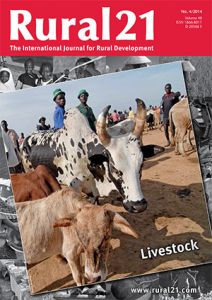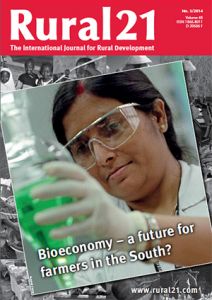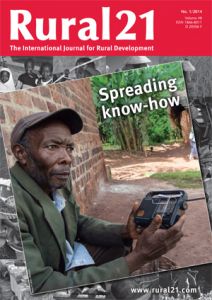Jahrgang 2014
-
Rural 21 (engl. Ausgabe 4/2014)Focus 4/2014: Livestock
The livestock sector creates livelihoods for an estimated one billion people world-wide. Not only is the consumption of milk, meat and eggs an important source of protein and micronutrients and hence a crucial pillar of food security for the rural poor in particular. For many people, the sale of animal products is the most important, if not the only, source of income. In addition, the animals are a significant multifunctional asset. They provide dung, raising soil fertility, they are simultaneously beasts of burden and tractors, and they represent “hoofed insurance”, not to mention the social prestige that they endow their owners with in several societies. In spite of its important role, animal production has been an unfavourable topic in the development debate – mainly because of its environmental impact. After all, animals account for two thirds of all climate gas emissions from agriculture; water pollution and loss of biodiversity are attributed to animal husbandry as are the transmission of animal-borne diseases to humans and unhealthy food, not to mention competition with other areas of food production. With this edition of Rural 21, we want to take a look at the current state of debate. Erfahren Sie mehr -
Rural 21 (engl. Ausgabe 3/2014)Focus 3/2014: Bioeconomy
Bicycle frames made of bamboo, kerosene made from algae, trainer soles out of rice husks – there seem to be an infinite number of ideas when it comes to replacing fossil, finite raw materials with renewable, seemingly infinite resources. The proponents of the economic approach summarised as the bioeconomy are not only focusing on using renewable raw materials. Rather, they regard their concept of “biologising the economy” as an opportunity to redesign the global system of production and consumption in a manner guaranteeing a secure sustainable base in every respect. This would be a gain for all – human beings and the environment, business and consumers, North and South. It indeed seems an ambitious project. This edition takes a look at whether the promises made in the context of the bioeconomy really can be kept and, above all, what conditions then have to be fulfilled. Erfahren Sie mehr -
Rural 21 (engl. Ausgabe 1/2014)Focus 1/2014: Spreading know-how
Over the last few decades, the range of agricultural extension and advisory services as well as the notions of which tools and methods are most suitable have seen fundamental changes. The concept of rural advising has long shifted from a linear transfer of technology to a pluralistic system of networks and innovations that brings the various stakeholders together and creates scope for mutual learning and exchange. More and more often, attempts are being made to move from the usual top-down transfer towards a demand-driven approach that actively involves farmers in the whole process – from prioritising and generating extension content to monitoring and evaluating the services. Regardless of the method or tool applied, it is ultimately always up to the farmers to make what they think is the right decision – and to hold responsibility for this decision. Erfahren Sie mehr





